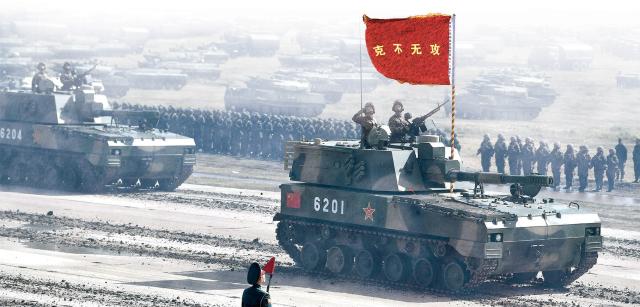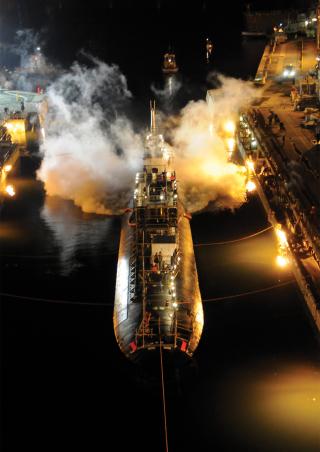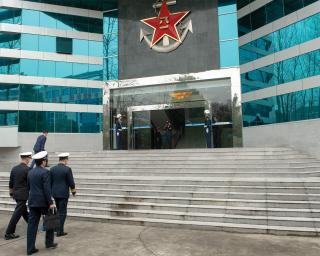
Captain Chen Liu surveyed the class from the back of the room. Hundreds of students, all midgrade officers in the PLAN, chatted excitedly with one another. He recalled being in their shoes more than 15 years ago, believing he was a master of his craft. He smirked at his naivete. Hopefully, he could teach his protégés what he wished he had known then.
Chen strode down the center aisle, climbed onto the stage, and surveyed the class as the class instructor called the room to attention. He could see their discipline and drive, even after punishing, back-to-back tours at sea for most of their careers. He nodded approvingly.
“Take your seats,” he said. As the class settled, he slid a remote control from his pocket and clicked a button, and the massive screen behind him flickered to life.
“Good morning. I’m Captain Chen, the Strategic Studies course director. On behalf of the Naval Command College, I’d like to welcome you aboard. I know you’re eager to learn everything you can. After graduation, you’ll be equipped to continue advancing the interests of China at sea.”
“But it’s most important,” Chen continued, “that we understand our strategic purpose. We must appreciate why we’re winning the war for global influence, and why the Americans continue to lose. As naval officers, we must learn why we will continue to defeat the U.S. Navy.”
Chen clicked, and an image appeared on the screen, a black-and-white photo of a squadron of torpedo bombers on board the USS Enterprise (CV-6).

“Stoking the fires of discontent, we turned not one but three U.S. sailors, convincing or paying them to set fire to another carrier and two submarines.” U.S. Navy
“The U.S. Navy was once the crown jewel of American military might. It could pull off such miracles as the Battle of Midway, which turned the tide of the War of Resistance to Japan and set conditions for American global hegemony that would last decades. How did America’s navy go from that . . .”
He clicked again, and more photos appeared: the burning USS Bonhomme Richard (LHD-6), destroyed by fire while pierside; the crumpled hull of the USS Fitzgerald (DDG-62); Captain Brett Crozier, relieved of command of the USS Theodore Roosevelt (CVN-71) in the early days of the COVID-19 pandemic; and, most famously, the USS America (LHA-6), hacked and rendered dead in the water, embarrassingly surrounded by numerous maritime militia fishing boats, and incapable of responding to the 2029 naval campaign that reunited China and Taiwan.
“. . . to becoming more a hindrance than a help to American strategic goals?”
Chen let the question hang. All the students knew the military operation that secured the reunification of Taiwan by heart; most had served in that campaign, and many had seen combat against the Taiwan Navy. But Chen was sure few had tied the lessons together, and fewer still understood the significance of these connections.
“These incidents were symptoms of a disease of purpose, a deep cancer that riddled the very heart of American military and naval culture. Sadly, for our adversary, it was a disease of which American security scholars and practitioners were keenly aware. They wrote about it in their professional journals, pointing out problems in defense bureaucracies and service cultures. The problems were so obvious that actively serving members of their military produced entertainment mocking them! Online comics such as Doctrine Man and Terminal Lance and satire like Duffel Blog illustrated problems so clearly that everyone from field grade officers to junior enlisted Marines could identify that something was terribly amiss.”
“The problem,” Chen said, “was one of ideals. Specifically, a grand ideal.”
He clicked again, revealing a black-and-white photo of a pilot, flight suit on and helmet in hand, standing up out of the open cockpit of a fighter jet. “This is Colonel John Boyd. An Air Force pilot turned military strategist, as brilliant as he was cantankerous. Boyd’s ideas saw a renaissance in the late 2010s, informing strategies that relied on many of his key concepts such as asymmetry, the weaponization of time, and cognitive defeat mechanisms. These ideas sound familiar to us—Boyd studied Eastern as well as Western military history, and you can find Sun Tzu and Mao speaking loudly in Boyd’s work.”
“But perhaps his most important contribution to strategic thought was that of ‘the grand ideal.’ That is, a nation’s vision and moral purpose.”
The photo of Boyd faded as a quotation was superimposed on it. Chen spoke again:
“In Boyd’s words: ‘A grand ideal, overarching theme, or noble philosophy that represents a coherent paradigm within which individuals as well as societies can shape and adapt to unfolding circumstances—yet offers a way to expose flaws of competing or adversary systems.’”1
Chen nodded appreciatively, chin up, staring at the screen, then slowly turned back to his audience.
“This should illustrate why an organization like a navy exists at all. What purpose does a navy serve? Self-defense, while a function of any government, is not enough. Why should we defend our form of government? Why should we expand our way of life? Why should we oppose a different philosophy, or a competing way of life?”
“That,” Chen said, emphasizing his point with a stamp of his foot, “is the point. A nation’s grand ideal must inform its government, its military, and its navy. It must inspire the consequential actions of naval leaders, who must put that vision ahead of themselves, their ambitions, and personal comforts. And if such a vision can be imparted from the highest levels of government to naval leaders, it will provide incredible operational advantages.”2
Chen clicked again, and photos of the fiery Bonhomme Richard, the crippled Fitzgerald, the COVID-ridden Theodore Roosevelt, and the disabled America returned to the screen. Chen pointed at the images.
“The U.S. Navy failed to act on America’s grand ideals.”
The next slide showed the cover of the 2018 U.S. National Security Strategy. “The ideals were no secret,” Chen said. “Liberty and independence across the globe, safety and prosperity at home, protecting human rights and personal dignity, and keeping America strong enough to promote these values. U.S. presidents regularly publish some form of this vision for America’s place in the world.”
“The U.S. Navy translated the American vision—its grand ideal—into guidance its leaders could execute. Strategic imperatives and core values were clear. So, what went wrong?”
The next slide showed the cover of the RAND Corporation’s 2020 Raising the Flag report. “Again, the answer wasn’t a secret. The RAND Corporation analyzed how each American military service’s personnel policies influenced their selection of flag and general officers. Three of its chief findings stand out.”
Chen raised his index finger, numbering his point. “First, American personnel systems discouraged risk-taking in professional performance. Rocking the boat is not rewarded in the U.S. military. The Japanese express this simply: ‘The nail that stands up gets hammered down.’”
Walking across the stage, Chen lifted another finger. “Second, as the Americans themselves say, ‘Ducks pick ducks.’ U.S. military promotion and command boards selected those with careers similar to those sitting the boards. These factors supported the selection of generations of leaders who reinforced habits of action throughout the American naval service.”

The People’s Liberation Army Navy Command College in
Nanjing, China. U.S. Navy (Elliott Fabrizio)
Centering himself on the stage, Chen finally raised a third finger. “And, specifically within the U.S. Navy, command at sea was one of the most important hallmarks of those promoted and selected for command.3 What does all this mean?”
With another click, a set of scales appeared on the screen. Raising the Flag sat in the bowl on the left, while the National Security Strategy, National Defense Strategy, A Design for Maritime Superiority 2.0, and the Navy’s Core Values Charter were piled in the bowl on the right. The scales tipped in favor of the Raising the Flag report.
“In the U.S. Navy, supporting America’s grand ideal was the biggest personal risk a leader could take.”
Chen let the statement hang, slowly looking across the class, making eye contact with as many students as he could. The nodding heads, half smiles, and widening eyes showed him what he wanted to see: They are getting it. He went on.
“Imagine you’re a weapons division officer, and your ship is preparing to get underway. You’re behind on certifying your division’s readiness, you lack the manpower to accomplish the task, and your department head is breathing down your neck. Will you be the one to say you won’t be ready in time?” Chen raised his hand, pointed at the screen and the Raising the Flag report. “Not if you want to get promoted. So, you ‘pencil whip it’ now and try to work it covertly once you’ve put to sea.”
“Now, let’s say you’re the combat systems department head, and your weapons division officer wants to submit a casualty report that could prevent you from leaving port. Are you going to enter it into the system?” Again, Chen dramatically pointed at Raising the Flag. “Not if you want to get promoted.”
“Now imagine you’re the ship’s captain, and your department heads are telling you there aren’t enough qualified officers to man all the watches while also ensuring crew rest. Are you going to tell the commodore you can’t deploy on time?” Chen snorted. “Not if you want to get promoted.”
“And so on, all the way up to the highest levels of command. You’re a fleet commander, desperately hoping for that fourth star, and you are keenly aware of systemic problems in training, readiness, and maintenance that, if adhered to by the letter, would sideline an entire squadron. When you get an order to put one of your ships to sea, are you going to say no?” Slowly, his face a mask of disappointment, he shook his head from side to side. “Not if you want to get promoted.” He could see some students mouthing the mantra along with him.
The next slide showed several images: the keel laying for another aircraft carrier, a squadron of F-35 Joint Strike Fighters, and glossy slides of increasingly complex families of communications and intelligence systems.
“Such habits informed other key areas of the U.S. Navy. Their strategic documents called for cheaper and more expendable ships, allowing for greater production and larger fleets that would complicate our strategic calculus. But the ships they commissioned only grew larger, more exquisite, fewer, and less expendable. The bulk of the budget still went to nuclear submarines, aircraft carriers, and next-generation fighter jets. The same senior leaders who claimed they needed fewer queens and more pawns on their chess boards approved mainly queen after queen, countering their own strategy . . . and playing right into ours.”
“So, too, with their program managers. Anyone can succumb to the sunk-cost fallacy, but U.S. naval acquisition leaders proved to be perhaps the most susceptible of all. Moreover, program managers who kill poorly performing programs don’t climb the ladder. Those who meet schedules and come in under budget do. Is it any surprise that the U.S. Navy continued to accept ships of every class with major defects that adversely affected performance? And the incestuous relationship between the American military-industrial complex and the military it serves only exacerbated the problem. Those few who objected to questionable programs were moved to new assignments or shown the door, as more pliable officers took their places.”
“For decades, then, if U.S. naval officers pursued the American grand ideal,” Chen said, “they would almost surely be relieved or become noncompetitive for promotion. The yes men, you see, had a lower chance of being fired. Occasionally, their luck would run out, and a major incident would ensue, such as a ship crash. Senior leaders would respond predictably: Relieve a commander; conduct an investigation; vow to do better. Then fail to incorporate the lasting change that could prevent the conditions that lead to such incidents in the first place.” Chen shrugged. “Ducking responsibility was a more viable strategy for upward mobility.”
The slide faded, replaced once more with the tipped scale favoring Raising the Flag. “This is a failure to turn ideals into action. As the Party will tell you, it is a condemnation of the very ideals themselves. This is what selfish ambition gets you: a failed imperial instrument that collapses beneath the weight of its own corruption. This creates an enemy all too easy to defeat, provided we fight with our own grand ideal still intact.”
The scale vanished, and the screen filled with the iconic image of the raising of the People’s Republic of China flag over the Presidential Office Building in Taipei, commemorating the official reunification of the island with the mainland the year prior, 2029.
“We sowed the seeds for this victory for generations. Not just the PLAN, but our entire society was working toward this moment. The United States and its navy, on the other hand, set themselves up for failure. Its fleet was fat with expensive, defective, poorly maintained ships full of vulnerabilities and undertrained and overworked crews; it was no surprise when one carrier and three destroyers crashed in the same month. Stoking the fires of discontent, we turned not one but three U.S. sailors, convincing or paying them to set fire to another carrier and two submarines.”
A wry, contemptuous smile spread across Chen’s face. “And we were patient, waiting for the Americans to make another mistake, which they seemed too eager to do. In the midst of this readiness crisis, saber-rattling in Iran led them to send a carrier task force to the Middle East. Despite America’s vaunted ‘pivot to the Pacific,’ the imperialists could not resist the chance to score an easy win against a lesser enemy. They diverted their most capable ships to face their least capable adversary. And when we struck at Taiwan, the lone big-deck ship available to get to the theater in time—filled to the brim with exquisite and fragile C4I networks—had been compromised by our cyber operators for years.”
Once more, the screen flashed the image of the helpless America in the South China Sea, surrounded by dozens of maritime militia trawlers. Chen shook his head and grinned at the photo. “We hacked the ship, rendered it helpless, then pushed the story everywhere we could in the news, on the internet, in media. The sailors on board streamed videos of their worsening conditions, which we happily amplified on every social media platform. The United States was unable to support the rebels in Taiwan and forced to accept the offramp we offered.”
“We beat the U.S. Navy without fighting it.”
Clapping his hands together, Chen looked across the entire classroom. “So as aspiring strategists, we must ask: When did we win? It wasn’t when we launched the hypersonic missile barrage on Taiwan, destroying their ports, airfields, and command centers. It wasn’t when we surrounded Taiwan with minefields, effecting a blockade. It wasn’t when our special forces and cyber operators took control of the island’s remaining infrastructure. It wasn’t even when PLAN marines raised the Chinese flag over the Presidential Office in Taipei.”
Chen clicked for the last time, revealing again the image of the tipped scales, this time Boyd’s quote superimposed. Chen turned and faced the students. “We won years and years ago. We won when the U.S. Navy forgot America’s grand ideal and applied malignant ideals across their service, feeding the cancer that ate it from within. And so long as they continue to forget their unifying vision, and as long as we remember ours, we will not be stopped.”
“We live and die for our country. ‘Serve the People’ is our motto, and it echoes in our very bones.”
Chen locked eyes with the student nearest him.
“Can the U.S. Navy say the same?”
No comments:
Post a Comment